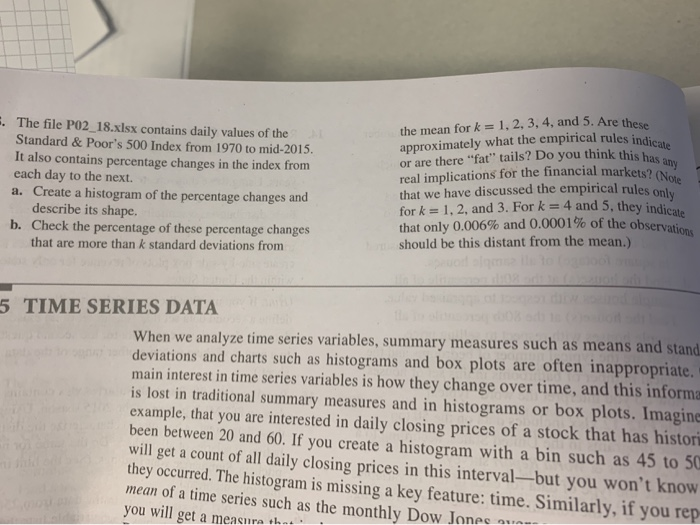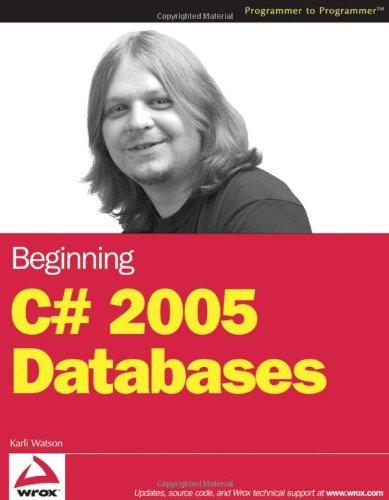Answered step by step
Verified Expert Solution
Question
1 Approved Answer
I need help with chapter 2 question 18 in Data Analytics: data analysis and decision making by s. christian albright. the example given on this
I need help with chapter 2 question 18 in Data Analytics: data analysis and decision making by s. christian albright. the example given on this website is using stat tools and i need to learn how to do it without stat tools. is this possible?

what other information do i need to provide? can you not go to the textbook that is on the chegg website? i provided a photo of the question that i need help with the solution page on the text book only shows how to solve with stattools but i dont have access to stattools so i need help learning how to do another way. i cant upload the excel sheet bc there is no attatchment link and its 11523 cells long
ules indicate k this has my arkets? (Note . The file P02_18.xlsx contains daily values of the Standard & Poor's 500 Index from 1970 to mid-2015. It also contains percentage changes in the index from each day to the next. a. Create a histogram of the percentage changes and describe its shape. b. Check the percentage of these percentage changes that are more than k standard deviations from the mean for k = 1, 2, 3, 4, and 5. Are the approximately what the empirical rules indi or are there "fat" tails? Do you think this ha real implications for the financial markets? that we have discussed the empirical rules on for k = 1, 2, and 3. For k= 4 and 5, they indi that only 0.006% and 0.0001% of the observa should be this distant from the mean.) observations 5 TIME SERIES DATA When we analyze time series variables, summary measures such as means and stand deviations and charts such as histograms and box plots are often inappropriate. main interest in time series variables is how they change over time, and this informa is lost in traditional summary measures and in histograms or box plots. Imagine example, that you are interested in daily closing prices of a stock that has histor been between 20 and 60. If you create a histogram with a bin such as 45 to SC will get a count of all daily closing prices in this intervalbut you won't know they occurred. The histogram is missing a key feature: time. Similarly, if you rep mean of a time series such as the monthly Dow Jones own you will get a measure that ules indicate k this has my arkets? (Note . The file P02_18.xlsx contains daily values of the Standard & Poor's 500 Index from 1970 to mid-2015. It also contains percentage changes in the index from each day to the next. a. Create a histogram of the percentage changes and describe its shape. b. Check the percentage of these percentage changes that are more than k standard deviations from the mean for k = 1, 2, 3, 4, and 5. Are the approximately what the empirical rules indi or are there "fat" tails? Do you think this ha real implications for the financial markets? that we have discussed the empirical rules on for k = 1, 2, and 3. For k= 4 and 5, they indi that only 0.006% and 0.0001% of the observa should be this distant from the mean.) observations 5 TIME SERIES DATA When we analyze time series variables, summary measures such as means and stand deviations and charts such as histograms and box plots are often inappropriate. main interest in time series variables is how they change over time, and this informa is lost in traditional summary measures and in histograms or box plots. Imagine example, that you are interested in daily closing prices of a stock that has histor been between 20 and 60. If you create a histogram with a bin such as 45 to SC will get a count of all daily closing prices in this intervalbut you won't know they occurred. The histogram is missing a key feature: time. Similarly, if you rep mean of a time series such as the monthly Dow Jones own you will get a measure that Step by Step Solution
There are 3 Steps involved in it
Step: 1

Get Instant Access to Expert-Tailored Solutions
See step-by-step solutions with expert insights and AI powered tools for academic success
Step: 2

Step: 3

Ace Your Homework with AI
Get the answers you need in no time with our AI-driven, step-by-step assistance
Get Started


